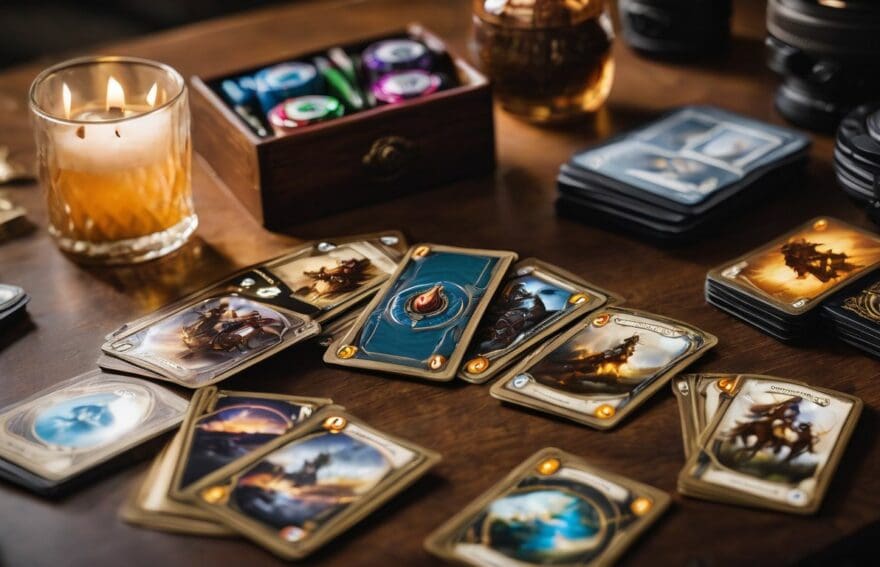Hearthstone Deck Archetypes Guide: Strategies for the Current Meta

Updated On: November 12, 2025 by 
Are you finding yourself stuck on the Hearthstone ladder with a deck that seems to lack the edge? We completely understand your frustration – it’s something many of us have grappled with.
But fret not, for we’ve dived headfirst into the nuances of deck construction and come up with a plethora of strategies suited to every archetype imaginable. Our guide is designed to help you pinpoint and refine a deck that not only aligns perfectly with your personal playstyle but also holds its own in the ever-evolving meta.
Keep your chin up – triumph is just around the corner!
The Importance of Choosing the Right Deck
Your deck has a significant impact on your gameplay, so choosing the right one is crucial. Understanding deck archetypes can help you tailor your strategy to suit your playstyle and preferences.
How your deck impacts your gameplay
Our choice of deck is a crucial component that determines our success in the game. Each archetype, whether it’s aggro, midrange, control, or combo decks, has unique strategies that influence how we approach each match.
Picking an aggro deck will have us putting pressure on opponents from the get-go, trying to win quickly before they can mount a defence. Alternatively, selecting a control deck means we’re planning for the long game where patience and carefully considered plays lead to victory.
We must also take into account our personal playstyle when deciding on a deck strategy. The synergy between our natural tendencies and our chosen deck enhances our gameplay experience and increases our chances of winning matches.
If swift and aggressive moves appeal to us more than strategic endurance battles, then aggro or tempo decks are likely better suited to us than control variants. It’s about finding harmony between what the meta demands and what aligns with our preferences for enjoying Hearthstone at its fullest.
Understanding deck archetypes
Transitioning from how your deck impacts your gameplay, understanding deck archetypes is crucial for mastering Hearthstone strategies. There are four primary deck archetypes in Hearthstone: aggro, midrange, control, and combo.
Aggro decks focus on fast-paced aggressive play and overwhelming opponents with early game pressure. Midrange decks strike a balance between aggression and control, aiming to dominate the board in the mid-game.
Control decks prioritise defensive play and aim to outlast opponents by controlling the game until they run out of resources or can be hit with a decisive blow. Lastly, combo decks revolve around assembling specific card combinations to execute powerful win conditions.
Different Types of Decks in Hearthstone
There are various types of decks in Hearthstone, each with its own unique playstyle and strategy. From aggressive aggro decks to slow and controlling control decks, understanding the differences between these archetypes will help you choose the right deck for your preferred style of gameplay.
Aggro decks
Aggro decks are an aggressive deck archetype that focuses on quick, early-game dominance and aims to overwhelm opponents with fast-paced, relentless aggression. These decks typically favour low-cost minions and efficient damage spells to apply pressure from the very beginning of the game.
The key strategy of aggro decks is to swiftly bring down the opponent’s health total and seize victory before control or midrange decks can stabilise. In the current meta, aggro decks tend to excel in faster matchups, showcasing their strengths in punishing slower strategies and catching opponents off guard with their swift offensive tactics.
Aggro decks represent a popular choice for players who prefer an assertive playstyle focused on high-speed action and decisive victories. With a range of aggressive options available across different classes, such as Face Hunter and Aggro Shaman, mastering these dynamic strategies can provide formidable advantages in competitive gameplay situations.
Midrange decks
Transitioning from our discussion of Aggro decks, let’s delve into Midrange decks. In Hearthstone, Midrange decks strike a balance between the aggressive nature of Aggro and the defensive capabilities of Control decks.
The main goal is to establish board presence early on while also maintaining enough resources to outlast Aggro opponents and overpower Control players. This versatility allows players using Midrange decks to adapt their strategy based on the current matchup, making it an appealing choice for those who enjoy a more flexible playstyle.
With strong mid-game minions and efficient removal tools, Midrange decks can offer a well-rounded experience for players looking to explore various strategies within this archetype.
The popularity of Midrange decks often stems from their ability to challenge both faster and slower deck types in the meta. By utilising cards with moderate mana costs that provide value over time, these decks are known for applying consistent pressure without sacrificing late-game potential.
Control decks
Control decks in Hearthstone focus on outlasting opponents through defensive strategies and efficient resource management. These decks excel in prolonged matches, often aiming to take the game into the late stages where they can utilise powerful high-cost cards and win through attrition.
By employing tactics such as board clear spells, healing effects, and card draw engines, control decks seek to maintain control of the game until they can overwhelm their opponent with superior late-game threats.
In the current meta, control decks provide a strategic challenge for players who prefer a more methodical approach to gameplay, requiring careful decision-making and foresight.
Combo decks
Combo decks aim to assemble specific card combinations, often involving multiple cards played in sequence for a powerful effect. These decks focus on creating explosive turns and game-winning combos by combining cards that synergise well together.
Players who enjoy strategic planning and executing intricate sequences will find combo decks particularly engaging. Successful combo deck players need to carefully manage their resources and bide their time until they can unleash their devastating combinations.
Understanding the intricacies of each card’s interaction within a combo is vital for mastering this archetype, as it requires meticulous attention to detail and precise timing. Combo decks add an exciting element of surprise to matches, keeping both players engaged throughout the game.
Assessing Your Playstyle and Preferences
Consider whether you prefer aggressive or defensive playstyles, as well as your preference for fast or slow games, in order to match your playstyle to a deck archetype. To learn more about how to choose the right deck and strategies for the current meta, continue reading our Hearthstone Deck Archetypes Guide.
Aggressive vs defensive playstyles
Aggressive playstyles involve fast-paced, high-risk gameplay aiming to deal significant damage quickly. These strategies are often favoured by players who enjoy pressuring opponents and pushing for victory in the early game.
Aggro decks are an example of aggressive playstyle decks designed to dominate the board and rush opponents down before they can stabilise their defences.
On the other hand, defensive playstyles focus on controlling the pace of the game, outlasting opponents, and making calculated moves to secure a late-game advantage. Control decks epitomise this approach, prioritising survival and resource management while patiently setting up for a decisive win condition.
Preferences for fast or slow games
When considering preferences for fast or slow games, it’s essential to understand how your playstyle aligns with the pace of a match. Aggressive players tend to favour fast-paced games, seeking quick victories through relentless attacks and early pressure.
Conversely, those who adopt a defensive approach often lean towards slower games, aiming to outlast opponents and capitalise on late-game strategies. Matching your playstyle to a deck archetype that complements your preferences is crucial for success in Hearthstone.
While aggro decks suit fast gameplay with their explosive starts and swift victory conditions, control decks cater more towards prolonged battles and strategic decision-making.
Understanding the nuances between fast and slow game preferences can greatly impact deck selection and overall performance. With each archetype offering unique play experiences and challenges, it’s important to consider not only personal inclinations but also the current meta when choosing a deck.
Matching your playstyle to a deck archetype
To find success in Hearthstone, it is crucial to align your preferred playstyle with a suitable deck archetype. Whether you enjoy aggressive, fast-paced gameplay or prefer a more strategic and defensive approach, there is a deck archetype that fits your style.
Understanding the characteristics of aggro, midrange, control, and tempo decks will help you make an informed decision about which type resonates with your gaming preferences. By considering factors like the pace at which you like to play and the level of interaction you seek with your opponent’s board, you can select a deck archetype that complements your strengths and enhances your overall gaming experience.
When choosing the right deck archetype for yourself, consider how each one aligns with your natural playing tendencies and strategic inclinations. Aggressive players may gravitate towards aggro decks due to their relentless pursuit of early game dominance, while those who appreciate adaptable strategies might find themselves drawn to midrange or tempo decks.
Researching and Analysing Popular Decks
Staying updated with the current meta is crucial for success in Hearthstone. We’ll explore how to evaluate the strengths and weaknesses of popular decks, as well as finding resources and guides for deck-building.
Keeping up with the current meta
To stay competitive, it’s crucial to keep up with the current meta in Hearthstone. By researching and analysing popular decks, players can gain insight into the strategies and tactics that are dominating the game.
Understanding the strengths and weaknesses of top decks is vital for making informed decisions when building or refining your own deck. Evaluating how popular archetypes perform against each other provides valuable knowledge for adapting your playstyle to counter prevailing strategies.
By keeping a close eye on the ever-changing meta, we can identify emerging trends and adapt our strategies accordingly. This involves seeking out resources such as weekly meta guides that discuss different variants of top decks, helping us recognise their prevalence on ladder and make informed choices about which archetype to play.
Evaluating the strengths and weaknesses of top decks
When evaluating the strengths and weaknesses of top decks, it’s important to carefully consider their performance in the current meta. Here are some key points to keep in mind:
- Analyse the win conditions of each top deck and how effectively they can be executed in different matchups.
- Consider the tempo and board control capabilities of top decks, as well as their ability to apply pressure on opponents.
- Evaluate the synergy between cards within a deck and how well they support its overarching strategy.
- Assess the resilience of top decks against popular tech choices and prevalent counter strategies in the meta.
- Examine the consistency of drawing key cards and executing game-changing combos within each top deck.
- Take note of any specific weaknesses or vulnerabilities that may be exploited by opponents in certain matchups.
- Look into the adaptability of top decks against evolving trends and shifts in the meta, considering their longevity and versatility.
- Consider the skill ceiling required to pilot each top deck effectively, as well as its potential for continuous improvement and mastery.
Finding resources and guides for deck-building
- Explore popular Hearthstone forums and communities online, where experienced players often share their deck-building strategies and offer advice on creating effective decks.
- Keep an eye on reputable gaming websites and blogs that regularly publish articles and guides focused on deck-building techniques, card evaluations, and meta analyses.
- Utilise deck-builder tools available on official Hearthstone websites or third-party platforms to experiment with different card combinations and refine your deck to suit your playstyle.
- Watch educational streams and videos from top Hearthstone players, as they often provide valuable insights into their thought process when building and refining their decks.
- Consider joining online communities or Discord servers dedicated to Hearthstone, where you can engage in discussions with like-minded players who are eager to share their knowledge of deck-building strategies.
- Look for comprehensive guidebooks or e-books written by experienced players or professional Hearthstone analysts that delve into advanced deck-building techniques, meta predictions, and strategic gameplay tips.
Building and Refining Your Deck
Choosing cards that complement your deck archetype and testing and tweaking your deck are essential steps in building and refining your deck. It’s also important to adapt to the ever-changing meta and consult with experienced players for valuable insights.
Choosing cards that complement your deck archetype
When building your deck, think about cards that enhance your chosen archetype. Consider how each card contributes to the overall strategy of your deck. Aim to include cards that align with the strengths and weaknesses of your selected archetype.
We should pay attention to synergy between the cards we choose and our deck archetype. Strive for a balance of powerful, game-changing cards and supportive, utility-based cards that reinforce your deck’s game plan.
Every card should serve a purpose in reinforcing the core identity and win condition of your chosen archetype.
Testing and tweaking your deck
Once you have built your Hearthstone deck, testing and tweaking it is crucial to its success. Playtesting against various matchups will help you understand how your deck performs in different scenarios.
Analysing the strengths and weaknesses of your deck through actual gameplay will enable you to identify which cards are underperforming or could be replaced with more effective options.
Continuously refining your deck based on real play experience ensures that it remains competitive in the ever-changing meta.
To fine-tune your deck, consult with experienced players who can provide valuable insights into card choices, mana curve adjustments, and tech decisions tailored to the current meta.
Importance of adapting to the meta
Understanding the current meta is crucial for success in Hearthstone. Adapting our deck to the ever-changing landscape of popular strategies and decks not only keeps us competitive but also enhances our gameplay experience.
By recognising shifts in the meta, we can make informed decisions about tweaking our deck composition, enabling us to counter prevalent tactics and seize any newfound opportunities that arise.
Staying attuned to the meta allows us to anticipate opponent strategies and adjust our own approach accordingly.
Remaining flexible within the meta ensures that we are equipped to handle various matchups effectively. This adaptability empowers us to maintain an edge over opponents who may not be as quick to respond or evolve their decks in line with changes in playstyles and trends.
Consulting with experienced players
When consulting with experienced players, it’s essential to seek advice tailored to your chosen deck archetype. Seasoned players can offer valuable insights into optimising card choices and refining gameplay strategies based on their own experiences.
Engaging in discussions with these experts can provide practical tips for adapting your deck to the ever-changing meta, helping you stay competitive and well-prepared for various matchups.
Engaging with experienced players can broaden your understanding of advanced mulligan techniques and high-level decision-making skills, empowering you to master your chosen deck archetype.
By absorbing their wisdom and incorporating it into your practice sessions, you can gain a deeper understanding of the nuanced nuances that define top-tier gameplay – ultimately propelling yourself towards further improvement and success in the current meta.
Mastering Your Chosen Deck
Understanding mulligans and game strategies is crucial when mastering your chosen deck. Practising with your deck against various matchups will help improve your decision-making skills and overall gameplay.
Understanding mulligans and game strategies
When starting a game of Hearthstone, it’s crucial to understand the importance of mulligans and how they can impact your game strategy. Here are key points to consider:
- Mulligans determine the cards you start with, giving you a chance to shape your opening hand for optimal gameplay.
- Knowing which cards to mulligan for based on your deck archetype and matchup is essential for gaining an early advantage.
- Understanding the specific mulligan strategies for aggro, midrange, control, and tempo decks can greatly influence your early-game decisions.
- Identifying key cards that can swing the match in your favor or disrupt your opponent’s strategy sets the foundation for a successful mulligan phase.
- Adapting your mulligan approach based on the current meta and anticipating popular matchups is a skill that separates experienced players from newcomers.
Practising with your deck against various matchups
- Analyse Matchup Data: Review each matchup to understand the opponent’s strengths and weaknesses, allowing you to tailor your game plan accordingly.
- Simulate Scenarios: Create specific scenarios during practise sessions, such as dealing with aggressive opponents or countering control decks, to enhance your decision-making skills.
- Experiment with Tech Cards: Incorporate tech cards into your deck based on prevalent matchups in the meta, enabling you to improve your win rate against specific archetypes.
- Adapt Your Sideboard: Fine-tune your sideboard options for tournament play by considering prevalent matchups and refining counterplay strategies.
- Seek Feedback: Engage in discussions with experienced players or join gaming communities to gather insights on effective approaches for diverse matchups.
Improving your decision-making skills
Mastering your chosen deck involves improving your decision-making skills. By analysing matchups and predicting opponent moves, we enhance our strategic thinking during gameplay. Utilising experience gained from practising against various decks allows us to make informed decisions tailored to specific situations, contributing to a deeper understanding of game dynamics.
This active involvement in the decision-making process refines our ability to adapt and respond effectively, ultimately elevating our overall gameplay.
Understanding how different archetypes perform against each other helps us recognise opportunities for making optimal decisions during matches. As we continue building on these skills, we become more adept at gauging risks and rewards when executing our strategies, thus enhancing the overall gaming experience and success rate.
Conclusion and Next Steps
After mastering your chosen deck, it’s important to stay updated with the ever-changing meta of Hearthstone. Resources and communities are available for continued improvement and learning from experienced players can help you refine your skills further.
Keep honing your strategies and staying ahead in the game!
The ever-changing meta
The ever-changing meta in Hearthstone demands constant attention and adaptation. As new cards are released and balance changes are made, the dynamics of the game shift, impacting deck viability and strategy.
Staying informed about popular decks, emerging trends, and shifts in playstyles is crucial for success in the ever-evolving meta. Understanding how different archetypes interact with one another and being able to predict or anticipate prevalent strategies will give players an edge in navigating this dynamic landscape.
In order to thrive within this environment, it’s essential to remain flexible and open-minded when it comes to deck choices and playstyles. Keeping a finger on the pulse of the meta through online resources such as tier lists, community forums, or professional streamers can provide valuable insights into prevailing tactics and potential counters.
Resources and communities for continued improvement
For continued improvement in Hearthstone, players can turn to various online resources and communities. These platforms provide valuable insights into the current meta, popular decks, and strategies being used.
By engaging with these resources, players can gain a deeper understanding of the game’s dynamics and discover new deck-building techniques. Additionally, joining gaming communities allows players to exchange ideas, seek advice from experienced players, and stay updated on the latest trends within the game.
This collaborative approach enables gamers to refine their skills through shared knowledge and collective expertise.
Furthermore, dedicated websites offer deck builder tools and meta tier lists that aid players in constructing their own effective Hearthstone decks. These resources empower gamers to make informed decisions when building or refining their decks by providing data-driven analysis of card choices and optimal strategies for different archetypes.
FAQs
1. What are Hearthstone deck archetypes?
Hearthstone deck archetypes are specific types of decks built around certain strategies to help players win in the current meta of the online card game.
2. How do I build a strong Hearthstone deck?
To build a strong Hearthstone deck, focus on mastering deck building techniques that match your preferred playstyle and counter what other players are commonly using.
3. Can you explain some strategies for the current meta in Hearthstone?
Some effective strategies include carefully selecting cards that work well together and adapting your tactics based on popular decks you encounter while gaming online.
4. Is it important to stay up-to-date with deck building in Hearthstone?
Absolutely! Continuously updating your knowledge about deck building and staying informed about new card releases can give you an edge over other gamers by refining your strategic play.


